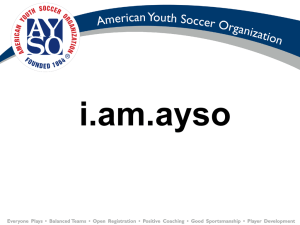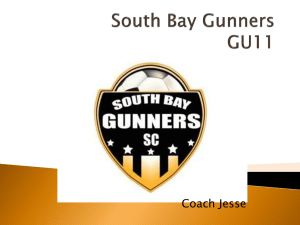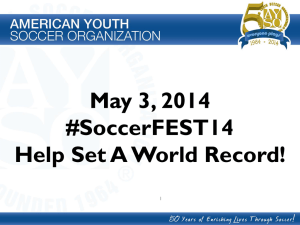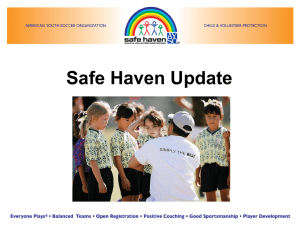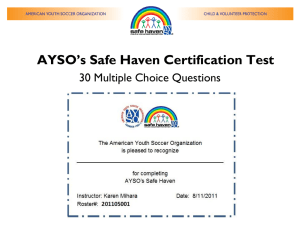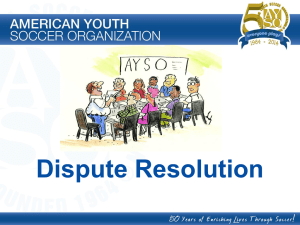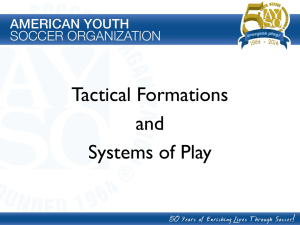Creating A Safe Haven - An Annual Refresher Powerpoint
advertisement
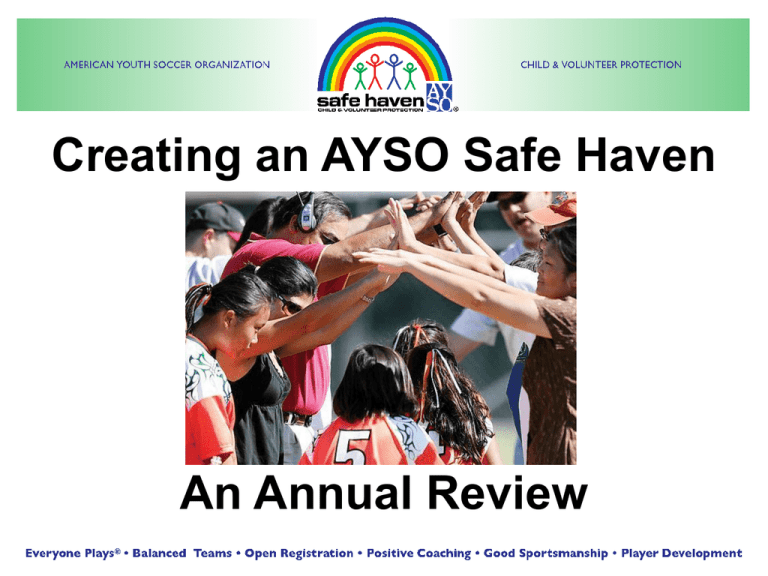
Creating an AYSO Safe Haven An Annual Review AYSO’s Safe Haven There are more than 500,000 children playing AYSO soccer and each one of those children has a right to a safe, fun, fair and positive environment for experiencing the benefits of youth sports. Thank You Thank you for volunteering to bring the AYSO experience to your community. Please keep the following guidelines and principles in mind as you work to create a safe haven for all AYSO participants. Vision The Vision of AYSO is to provide world class youth soccer programs that enrich children’s lives. Child Protection AYSO is a mandated reporter of suspected abuse in many states – there are legal reporting standards. We are either legally required or morally obligated to file a report of suspected abuse. Reporting Abuse Reporting is generally required when a child is: • physically injured by other than accidental means, subjected to willful cruelty or unjustifiable punishment, or sexually abused or exploited. • neglected by a parent or caretaker who fails to provide adequate food, clothing, shelter, medical care or supervision. Many states have penalties for failing to report. Emotional Abuse The most common; attacking the emotional well being and stability of an individual. Emotional Abuse • Legally required to report suspected abuses visibly effecting the emotional stability of the child. • Abusive behaviors not allowed in AYSO include making comments about the size, inability or appearance of a player in front of others. Jokes, even in fun, can be emotionally abusive. • Social bullying, derogatory comments and racial, ethnic or gender slurs must not be tolerated. Physical Abuse The most obvious; harming the physical well being of an individual. Physical Abuse • Legally required to report acts resulting in “any nonaccidental physical injury to the child” or circumstances that create a substantial risk of harm. • Abusive behaviors not allowed in AYSO include punishing players by making them run laps or denying water, corporal punishment, bullying or fighting. • AYSO has a zero tolerance policy for violence. Neglect Not always easy to identify: harming an individual by abandoning, ignoring, or rejecting basic needs. Neglect • Legally required to report the failure of a parent or guardian to provide needed food, clothing, shelter, medical care, or supervision. • AYSO does not allow neglectful behavior including never playing a below average player more than half of every game or consistently excluding a player from practice drills. • Players should not be allowed to exclude a single player or a few players from team activities. Sexual Abuse Frequently hidden; harming an individual through inappropriate sexual contact, lewd behavior, or exploitation. Sexual Abuse • Legally required to report any form of sexual abuse or exploitation. • AYSO prohibits making lewd comments, sexual harassment or any type of inappropriate physical contact. • Minors must be supervised to prevent minor-onminor abuse. • Please contact Safe Haven immediately with any concern. Ethical Abuse The newest identified form of abuse; harming an individual by convincing him/her to commit an act that is against his/her physical, moral, or ethical interests. Ethical Abuse • Abusive behaviors not allowed include asking a player to “take down” an opposing player or feigning an injury. • Adults should refrain from asking children to keep “secrets” from parents. • Youth volunteers should be encouraged to tell a trusted adult if told a “secret” about abuse. Suspecting Abuse • If abuse is suspected, notify the Child and Volunteer Protection Advocate (CVPA) and the National Safe Haven Office. 1-800-USA-AYSO. • If the abuse is considered life threatening, contact local law enforcement or Child Protective Services immediately. • Remember reporting is a means of helping; reporters simply report; agencies investigate. • Volunteers should not confront the accused. Preventing Abuse • Screening who volunteers in the AYSO program is just the first step. • Training volunteers to recognize abuse and abusive behavior is necessary to report and stop abuse. • It would all be meaningless unless we implement policies and guidelines to prevent opportunities for abuse to occur. • Experts agree that is also important to foster positive self-images, a safe environment and the courage in our players to speak up. Protection Guidelines Safe Haven’s Child and Volunteer Protection Guidelines are designed to protect children from abuse and volunteers from misunderstandings and false accusations. Supervision Protocols AYSO requires the following Supervision: • One adult for every eight or fewer children. • At least two adults present at ALL times. • At least one adult of the same gender as players. • Adults should never be alone with a child. Supervision Protocols Head Coach is responsible for the players on his/her team until they are picked up or otherwise leave the area. No child shall be left unsupervised after a game or practice. The AYSO “Buddy System” requires a minimum of 3 players. Supervision Protocols AYSO does not recommend that children walk or ride a bicycle home alone. However, if it is necessary, the Coach should secure a release form from the parent/guardian to ensure their approval. Protection Guidelines In order to prevent misunderstandings, physical contact with children should be: – In response to the need of the child only – With the child’s permission – Respectful of any hesitation – Careful to avoid private parts – In the open, never in private – Brief in duration – Age and developmentally appropriate Protection Guidelines • Adults should avoid being alone with a child including transporting a child in a car. • If it is necessary to speak privately with a child, select a spot out of earshot but within sight of others. • Set appropriate boundaries. • Maintain adult privacy. • Respect the privacy of children. • Hug from the side. • No sexual jokes, comments. • No corporal punishment. Protection Guidelines Social Media & Electronic Communications • Volunteers should maintain transparency and not engage in private electronic messages or conversations with minors. • Messages should be conveyed through parents or in the case of older players, copied to parents. This includes emails, text messages, instant messaging and postings on social networking sites. • Protect the identity and privacy of children at all times. Do not post names of players with pictures or rosters on public pages or banners. Protection Guidelines • It is illegal for minors to possess, control or use alcohol, tobacco products or prescription-only drugs without authority and may subject them to prosecution. • Any adult who knowingly provides such substances to a minor is subject to criminal prosecution. • The Volunteer Protection Act does not protect adults who violate alcohol, tobacco and drug laws. Protection Guidelines AYSO’s Rules & Regulations state that: “It shall be the duty of each coach and official to present a healthy, athletic environment for players by neither consuming alcoholic beverages or using tobacco products during practices or games or in the immediate vicinity of the soccer fields.” Play it Safe It is the responsibility of all participants to work together to minimize the risk of injuries and to create a safe environment. Emergency Medical Conditions • The primary role of all volunteers is one of injury prevention and first aid, not diagnosis or treatment of injuries. • It is important for everyone to recognize the symptoms of potentially serious medical emergencies and to know when to summon emergency medical professionals. Emergency Medical Conditions Bleeding • Can’t be stopped; call for medical assistance asap. • Apply pressure directly to bandage over the wound with gloved hand. If bandages becomes soaked, continue to add clean bandages on top. • For extremities, apply pressure to brachial artery inside upper arm between armpit and elbow or to femoral artery located on crease between leg and torso. • Cover victim to prevent shock. Emergency Medical Conditions Bleeding • Any player or official who is bleeding must leave the field immediately and may not return until the bleeding is stopped, the wound is cleaned and covered. • If there is blood on the uniform or clothing, the individual may not return until that portion of uniform is replaced or the blood is neutralized with an antiseptic solution. Emergency Medical Conditions Bleeding • Clean up a blood spill with absorbent paper towels and flood spot with a solution of ¼ cup bleach to a gallon of water. • Dispose of any blood stained materials in a biohazard container or tightly sealed plastic bags, using gloves and disinfecting solutions. • See appropriate local authority for disposal of biohazards. Emergency Medical Conditions Difficulty Breathing • If due to an allergic reaction, call 911 immediately. • Try to calm individual, help to position of comfort. • If a person is down from an injury to chest or airway, do not move unless absolutely necessary. • Do not place a pillow under head if lying down. • If necessary, begin rescue breathing (CPR). Emergency Medical Conditions Loss of Consciousness or fainting • For fainting, help person to lying down position. Summon medical help if they do not regain consciousness within a minute. • If unconscious due to head, neck or spine injury, do not move. • Check airway, breathing, circulation. Start CPR if necessary. • Stay calm and wait for emergency help to arrive. Emergency Medical Conditions Heat Exhaustion • Symptoms may include headache, feeling faint or dizzy, nausea, fatigue, heat cramps. Individual feels cool, clammy and damp to touch. • Move to cool area and shield from sun or external heat sources; recline with feet up. • If alert, give small sips of cool liquids. • Remove or loosen restrictive clothing, apply cool cloth to skin or spray with cool mist. Emergency Medical Conditions Heat Stroke • Feels hot and dry to touch. • If fever rises greater than 102 degrees, fainting, confusion or seizures can occur. • Summon professional medical help immediately and follow same procedures for heat exhaustion. Emergency Medical Conditions Hypothermia • Does not require sub-zero temperatures. • Can occur with high winds, rain, snowfall or underdressing for weather. • Early signs include: shivering, bluish tinge to lips. • Advanced symptoms include uncontrollable shivering, weakness, loss of coordination, slowed breathing or heart rate, and pale, blue, cold skin. Emergency Medical Conditions Hypothermia • Call 911 for advanced symptoms. • Prevent further heat loss; seek shelter from wind and cold. • Gently change wet clothing and provide warmth. • Do not rub extremities. Emergency Medical Conditions Concussions • Concussions are serious brain injuries that can cause death. • Coaches and parents should watch for 2 things among athletes: – A forceful blow to the head or body that results in rapid movement of the head – Any change in the athlete’s behavior, thinking or physical functioning. Emergency Medical Conditions Concussions • AYSO recommends the Center for Disease Control’s Heads Up program for concussion awareness training and information. • http://www.cdc.gov/concussion/HeadsUp/online_training.html Emergency Medical Conditions Concussion Signs and Symptoms •Forgets sports plays •Unsure of game, score, etc. •Moves clumsily •Answers questions slowly •Loses consciousness •Shows behavior or personality changes •Can’t recall events • • • • • • • • Headache or pressure Nausea or vomiting Balance problems or dizziness Double or blurry vision Sensitivity to light or noise Feeling sluggish, hazy, or groggy Concentration/Memory problems Confusion; Doesn’t feel right If there is a blow to the head or concussion is suspected: • Remove athlete from play and evaluate for symptoms. • Athletes with any symptom(s)should NOT return to play. • Inform parents of events, symptoms and encourage seeking professional medical care. Emergency Authorizations • Coaches must have signed/eSigned Player Registration Forms and any other required emergency authorization form on hand at all practices and games. • Youth Volunteers must carry a signed copy of their Youth Volunteer Application and any additional required emergency authorization form with them while conducting their AYSO volunteer duties. Environmental Hazards AYSO officials have the responsibility to be aware of potential environmental conditions that pose hazards to its participants. These conditions include: Hot Days Cold Days Lightning Tornados Wildfires Hurricanes Public announcements should take precedence over published general safety guidelines. Environmental Hazards Lightning Every AYSO event should have a lightning safety plan. Lightning can strike as far as 10 miles from where it is raining. When thunder is heard it is within striking distance – seek shelter immediately. Restart games after no thunder has been heard for 30 minutes or the ALL CLEAR SIREN has been sounded. Environmental Hazards Lightning – Seeking Shelter • Safer Areas – – Inside a fully enclosed metal vehicle with windows up Inside a substantial building (roof and four walls) • Unsafe Areas – – – Open areas like playing fields or parking lots. Picnic shelters, near Concession stands, under trees. Near flagpoles, goals, metal bleachers, electric equipment. • Open Area without shelter – – – Avoid standing in groups; spread out to reduce risk. Avoid being the tallest object; Avoid lying on the ground. Crouch on feet, keep head low. Environmental Hazards Take a moment at the beginning of activities to assess potential physical hazards which may include: Goalposts, Crossbars, nets. Foreign Objects: Broken glass, rocks, trash. Walls, fences, buildings near practice/game fields Sprinklers, Drainage grates. Seating Areas. Gopher holes, divots and bumps. Goalpost Safety • Goalpost accidents kill at least one child and injure hundreds annually. • Goals must be anchored and staked when in use. • Without counter-weights, the sturdiest of goalposts can be blown over by a gust of wind. • Children must never climb or play on goalposts. • When not in use, goalposts should be dismantled and/or stored securely, locked together or to a fence. AYSO Volunteers Remember what it means to be an AYSO Volunteer – we are entrusted with the AYSO Vision And willing or not, we are role models AYSO Role Models AYSO asks Volunteers to support the following principles designed to provide children with the maximum benefit from participating in youth sports. 2010 BASIC 49 AYSO Principles of Sport Create an environment that enriches children’s lives: – Athletics should develop the whole child by treating children as individuals, in an age-appropriate manner. – The objective of the game is to win, but the goal is ENJOYMENT! 2010 BASIC 50 AYSO Principles of Sport Promote the benefits of soccer and sport because soccer contributes to physical well-being and selfesteem. 2010 BASIC 51 AYSO Principles of Sport Remember the reasons kids play sports – to have fun! 2010 BASIC 52 AYSO Principles of Sport Model and promote good sportsmanship by demonstrating that winning is not the most important thing in sport. Model how to win and lose graciously. 2010 BASIC 53 AYSO Principles of Sport Model ethical conduct by maintaining emotional control and demonstrating respect for athletes, coaches, officials and others. 2010 BASIC 54 AYSO Principles of Sport Foster a “safe” learning environment by reacting positively to mistakes, offering encouragement and showing acceptance. 2010 55 AYSO Principles of Sport Participate in continuing education: – Stay updated on the following: • • • • Rule changes – AYSO, Laws in FIFA. Equipment improvements. Philosophical changes. Improved techniques to enhance health, safety and success of players and participants. – Attend Regional meetings and training courses. – Maintain records of completed training. 2010 56 AYSO Role Models Do not tolerate abusive behavior. – Document and report any misconduct. – Regional Boards should address any abuses, provide training and awareness, and if necessary take additional actions under the guidelines of Dispute Resolution and Due Process. – If bad conduct becomes threatening or violent, contact the AYSO National Office immediately. 2010 BASIC 57 Every AYSO venue is a kids zone! Kids Zone guidelines encourage appropriate sideline behavior – key to promoting a fun, safe, family-friendly environment. Parents and Spectators pledge to respect the tenets of Kids Zone. Coaches, Referees, Parents and Players abide by a Code of Conduct. Kids Zone Sidelines Spectators agree to respect the following rules: • • • • • • • • • • Kids are # 1 Fun, not winning is everything Fans only cheer, only coaches coach No yelling in anger Respect the volunteer referees No swearing No alcohol, tobacco products or other controlled substances No weapons Leave no trash behind Set a proper example of Good Sportsmanship AYSO Incident Report An Incident Report is required whenever there is a serious incident involving AYSO participants, activities, facilities, or property including: • • • • • • • Injuries Threats of bodily harm Fighting Property damage Hospitalizations Law Enforcement Lawsuits Volunteer Requirements For protection under the Volunteer Protection Act and applicable laws, AYSO requires all volunteers to: – Sign and submit a Volunteer Application every year, – Be authorized to do their job, – Act within the scope of their Job Descriptions and AYSO’s policies, procedures and guidelines, – Complete Safe Haven Training and – Be properly trained in their jobs. Remember, it’s for the Kids and Great Soccer Starts Here!
